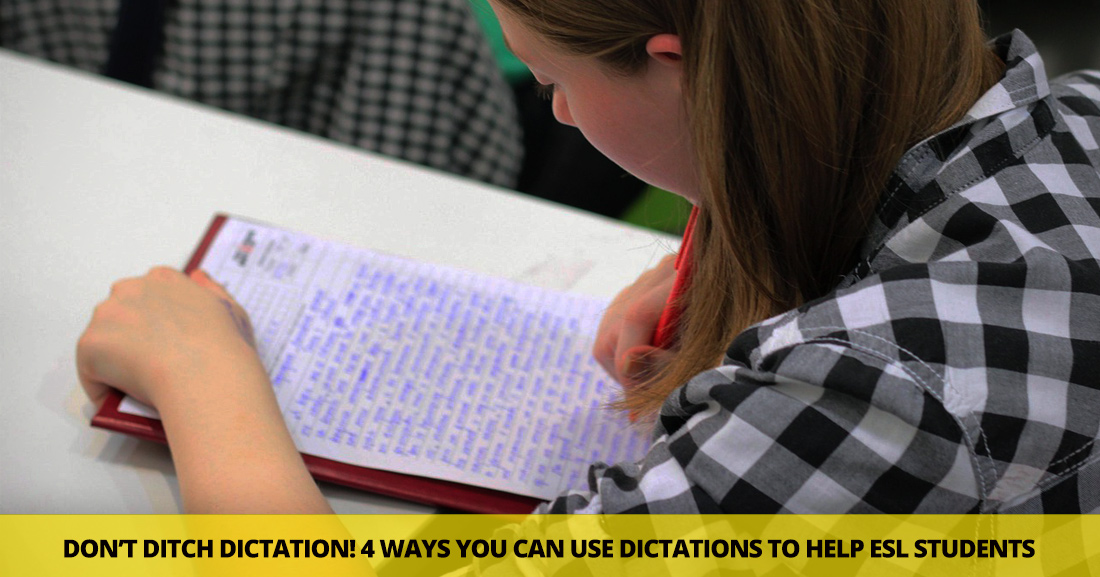Donít Ditch Dictation: 4 Fabulous Ways You Can Use Dictation to Help ESL Students


You are sure to find out with these activities that challenge your advanced students to listen closely.

In this activity, you will use inflection and intonation to give meaning to simple phrases. Start by choosing a few simple phrases such as Would you be so kind as to open the door. If you like, write the phrase on the board for your students. Then read the phrase using different intonation and inflection to communicate a different feeling through the words. You might say it sarcastically, exasperatedly, timidly, forcefully with frustration, etc. Challenge your students to guess what you were feeling as you said the words each time. Then challenge them to come up with their own phrases that can be intoned a variety of ways to give a different emotion behind the words. Give them a chance to say their phrases with a particular intonation and see if the class can guess the speaker’s intent behind his or her words.
Dictation is a challenge for anyone, especially if the speaker does not slow their speech to help the writer. It is also a great listening challenge for advanced students. Choose a passage to read to your students. You can choose something they have already read so they have some familiarity with the passage or choose something entirely new to them for an even greater challenge. Then read the passage aloud as your students write down what you say. . You will want to limit yourself to a paragraph or two. Start reading at a slower pace, increasing your speed as you go through the passage After you have finished reading, give your students a copy of the text and have them see how close they were to writing down what you actually said.
Do you normally dictate new vocabulary words to your students before giving them the words in writing? It’s a challenge, yes, but it is also good for developing listening skills and spelling skills. You can take this challenge to the next level by giving your students not isolated words but sentences that contain new vocabulary words. For each vocabulary word, write between one and three sentences. Your target vocabulary word should appear once. Then read each set of sentences to your students, one at a time. Students will listen to what you say and then try to determine which is the target vocabulary word. For example, if your vocabulary word was isolated, you might read this to your students: Maria had spent so much time pushing people out of her life, she was now completely isolated. For the first time in her life, she felt lonely. After reading the sentence, have students write down what they thought the vocabulary word was. Have students share their answers before revealing the true vocabulary word, and then ask students to offer up a tentative definition for the key word based on its context in the sentences.
This activity will challenge students to listen to each other while they are bombarded by noise in the room. Start by putting your students in pairs. One person from each pair will give directions to his partner. The other person will wear a blindfold and will try to retrieve certain objects from the room. Line the blindfolded students up along a line on one side of the classroom, and have their partners stand behind them. Then give each speaker a list of three to five items in the room for their partner to retrieve. Your list might include a pencil from the teacher’s desk, a book from the classroom library, a sticky note from one corner of the room, and a set of headphones from the listening area. The speaker will have to shout directions to his partner so that person reaches each object. All the walkers will be moving at the same time and in the same space, and the speakers will all be calling out from the same place. The goal is for each walker to retrieve the items on the list and then return to the starting line all without running into any classmates or objects. The first team to bring all of their items across the start line wins the game.
Telephone is always a fun listening game to play in ESL classes. Students get in a line, and the teacher whispers one sentence to the first person. That person must then whisper it to the next person in line and so on until the sentence reaches the last person in line. Each speaker can only say the phrase once. To make this game more challenging for advanced students, try whispering a tongue twister to the first person in line rather than a sentence. Not only will she have to listen carefully, but she will also have to speak clearly and slowly to pass the message along. Your tongue twisters don’t even have to be logical sentences. Sometimes a list of a few choice words is enough to get the tongue tied (rubber baby buggy bumpers, for example). Your students will get a laugh when the last person shares with the class what they heard and you share with the class the phrase that actually started the exercise.
Following verbal instructions can be tricky under normal circumstances, but what happens when the person giving instructions doesn’t show the listeners what he or she is doing? It’s a challenge just perfect for advanced listening students. In this activity, you will be giving your students instructions on how to make a simple origami project. You can find several instructional videos online, so use one of those to prepare the activity for your students. Your students will have to listen carefully and follow the directions they hear to make whatever project you choose for them. Start by choosing a simple project. Have your students listen to the instructions and follow along as they fold their own project. Once the instructions are complete, have students share their creations with the class. Give credit to anyone whose project looks just like it should. If you like, follow with more complex projects and see how well your students listen to and follow the directions.